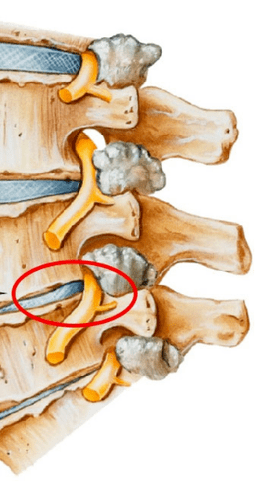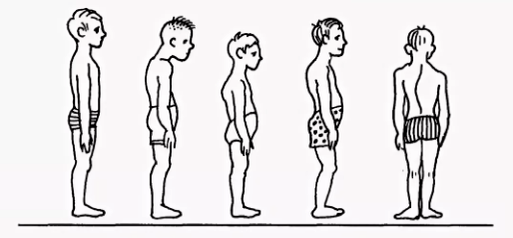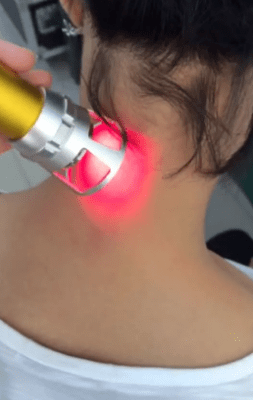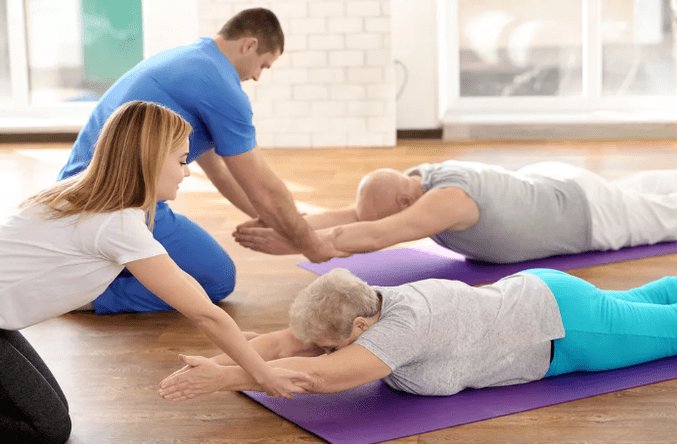Osteochondrosis is a chronic disease expressly expressed by dystrophic disorders in the joint cartilage. More often the osteochondosis of the spine occurs, when changes occur in the intervertebral discs and in the intervertebral joints. Depending on the location, cervical, thoracic and lumbar osteochondrosis stands out. Osteocondrosis is often found also in which all the spinal parts suffer. The pathology requires a consultation with a doctor and an integrated approach to treatment.

Description
The diseases of the spine, like other chronic diseases, are quickly "becoming younger". If previously back pain and the joints annoys the elderly, today patients aged 18-30 are increasingly dealing with doctors.
Scientists consider the immediacy of a person a prerequisite for the development of this disease, even an osteochondosis is facilitated by a prolonged session position. Furthermore, with age, the joint cartilage loses elasticity and elasticity, subtle; The intervertebral discs lose the humidity and the ability to absorb impacts, become vulnerable in the time of physical effort.
Reasons
The causes of cervical osteochondrosis reside in the loads and affect the cervical region in different circumstances. Consequently, the neck muscles begin to decrease intensely, thus compensating this load, following which a spasm occurs, as well as a violation of the blood flow in this area.
- The violation of scoliosis of posture, the curve, the round back, the cifosis and other posture disorders, even if they are insignificant, cause a serious violation of the balance of the spinal column. Consequently, the load on the intervertebral discs is distributed in a non -uniform way, which causes their deformation and an increase in wear. The vertebrae begin to approach, causing violation of the nerve processes, cervical osteochondosis develops quite quickly. Similar consequences have violations of posture caused by a change in the natural position of the ribs.
- Muscle spasms spasmodic reactions of the back muscles, breast, pressing can lead to the fact that the individual parts of the body are very tense. Consequently, the general balance position of the body is disturbed, causing a change in the position of the spine. Deformations can influence the region of the cervical region or other parts of the spinal column, causing osteochondous of the thoracic, cervical and lumbar parts.
- The violation of the flow of blood, since vertebrates do not have a direct connection with the circulatory system, receive nutrition from the surrounding tissues. The violation of the flow of blood to the cervical column leads to the fact that the discs do not receive quite liquids for rehydration (the restoration of the shape due to the absorption of humidity) and the renewal of the cartilage tissue. Consequently, their wear and tear is accelerated, there is a decrease in the distances between the vertebrae of the cervical region, which leads to osteochondosis.
- The violation of the nourishment, a decrease in the sensitivity of the nerve roots leads to pathological changes in their structure, due to which the movement and deformation of the vertebrae of the cervical region remain unnoticed by the patient. After all, the pain is absent due to sensitivity disorders.
- The diseases of the internal organs are the incorrect position of the internal organs, their movement and lowering due to various dysfunctions lead to a violation of the general balance in the body. Consequently, this acutely affects the position of the spinal column: the cervical vertebrae, the lumbar are moved and deformed, bringing to the corresponding types of osteochondosis.

In general, osteochondosis of the cervical region develops due to the effects of adverse external factors that violate the position of natural balance of the spinal column and other systems of the human body.
Diagnostics
The diagnosis of cervical osteochondosis begins with the collection of all the necessary information on the patient. The specialist asks for complaints that they annoy the person, he is interested in his professional activities, as well as how he spends his weekend. An important point is the presence of osteochondrosis in parents, grandparents, because this is a disease of hereditary nature.
So the doctor proceeds directly to the patient's visual examination. Study the cervical compartment and its shoulders to the curvature of the posture, palpa in the cervical region. This allows a specialist to evaluate the degree of development of the disease, since in advanced cases, palpation of the cervical region causes severe pain.
When examining, you should pay attention to:
- on the gravity of cervical lordosis;
- the height of the shoulders in the patient;
- the possibility of asymmetry of the above areas;
- the possibility of asymmetry of the neck (for example, a consequence of the congenital pathology or acute muscle spasm);
- The condition of the muscles of the shoulder belt and the upper limbs (for example, muscle atrophy on the side of the side can indicate a compression of the cervical spine);
- The position of the chin - the chin is normal should be positioned along the middle line;
- The movement of the neck (extinct the flexion, tilt the right and rotation and rotation).
Palpation is performed in the patient's initial position:
- lying on the back;
- lying on the stomach;
- Sitting on a chair.
The study of the volume of movements is also conducted. It is performed in the initial position of the patient sitting in a chair (to repair the other spine).
Distinguish the following basic movements in the cervical region:
- flexion;
- extension;
- The slopes on the right and left;
- Rotation.

About half of the volume of flexion and extension occurs between the rear of the head, the vertebrae of C1 and C2. The rest of the movement is performed due to the vertebrae below, with a vast scale of movements in the C5-C7 vertebrae. The lateral inclinations are distributed evenly among all the vertebrae.
To do precisely a diagnosis, further studies are prescribed:
- X -Ray of the cervical region. This method is appropriate in the early stages of the disease, but it can be useless in advanced forms.
- CT (computerized tomography). It allows you to see the structural changes in the vertebrae, but with the help of this method it is impossible to determine the size of the Arnia between the vertebrae.
- Mri. It is considered the most effective method to diagnose cervical osteochondrosis. You can determine the dimensions of the Nearnia between the discs and the degree of their development.
- The doctor can also prescribe a Duplex scan that allows you to determine a violation of normal blood circulation in the arteries.
Treatment
The treatment of cervical osteochondrosis is a complex therapy that includes the intake of drugs, gel and various physiotherapy measures. An important role is played by therapeutic gymnastics, as well as by the massage of the problematic area.
Drug
It is impossible to eliminate the consequences of degenerative dystrophic changes in the spine without the use of drugs. The use of medicines in the treatment of osteochondosis of the cervical region is one of the main points of the complex approach to healing, used by most of traditional medicine specialists.
It is designed to solve several problems, including:
- stop the symptom of pain and eliminate the inflammatory process;
- remove muscle spasm;
- Stimulate the process of regeneration of cartilage and bone tissue cells;
- strengthen the protective properties of the body, increase immunity;
- It improves the general condition by eliminating other symptoms that interfere with recovery.
Depending on these purposes, all drugs prescribed by a doctor suffering from cervical osteochondrosis can be conditioned in the following groups:
- Analgesics (non -pound drugs that relieve pain).
- Anti -inflammatory (steroids) are hormonal drugs that relieve inflammatory phenomena and thus eliminating pain.
- The chondroprotectors are drugs containing substances that replace the components of the cartilage tissue - chondroitin, hyaluronic acid.
- Musorelassanti. These are drugs that relax muscle tone. They are used in surgery and orthopedics as auxiliary remedies to stop pain. These drugs are administered by parentel and therefore always under the supervision of a doctor.
- Vitamins. With osteochondrosis of the cervical region, vitamins are prescribed, benefiting the peripheral nervous system and improving conductivity. Soluble vitamins in water: B1, B6, B12, vitamins containing fats: A, C, D, E. in recent years, combined drugs containing pain relievers and vitamin components more often.
- Ointments and gel for external use.

Physiotherapy
The main objective of physiotherapy treatment is to stimulate the regeneration process in the body and eliminate pain. The most popular methods in the treatment of the cervical chonds are as follows:
- Ultrasound. Fisio with ultrasound waves is used to relieve serious pain manifestations and inflammatory reaction. The ultrasound is massage the fabric of the neck, after which the metabolism is activated.
- Vibrations massage. The impact on the pain area during the vibrations massage is through mechanical oscillating movements. For the correct conduct of this physiotherapy, a stripe vibrator is usually used.
- Electrophoresis. This method of conducting physiotherapy treatments for cervical osteochondrosis is performed using dialing and modulated currents, as well as electric fields when the body is administered in drug tissues. The electrophoresis perfectly relieves spasmodic syndromes and eliminates pain in the inflamed muscles.
- Magnetotherapy. The essence of magnetotherapy as physiotization in osteochondrosis of the cervical region is explained through the use of constant fields or fields with magnets, a frequency of different sizes. This method can help the patient remove pain and stop the inflammatory process in the hearth. The procedure is often performed at home after acquiring a special magnetographer.
- Therapy-Therapy Dutoenzor. Currently, a rather popular physiotherapy method, constituted in lengthening the spine under the mass of the patient's body. To perform this procedure, a mattress arranged in a special way is necessary, which has inclined ribs and change the position under the weight of its body. The muscle tone is normalized, which leads to their relaxation.
- Laser therapy. The laser has a complex effect on the focus of inflammation, activates biological processes in the tissues of the nervous system. This allows you to obtain a positive effect from the treatment. A complex effect on the body consists in the effect of anti -inflammatory, analgesic and wounds. A laser treatment procedure should not exceed 15 minutes. This is the optimal time of the sectoral exposure of the helmet-neon laser in the areas concerned. In this case, the duration of the laser on pain should not exceed 2 minutes.
- Balnetherapy. The benefits of mineral water have been known for a long time, this is what is based on bathing. The procedure implies the active use of water resources in the treatment of osteocondrosis. In addition to the adoption of bathrooms, different types of souls and active swimming in the pool, the therapy involves the use of the therapeutic mud applications to painful areas of the body. The therapeutic effect is obtained from the simultaneous effect of chemically active substances contained in water under various temperature conditions. The technique allows you to stop pain syndrome by improving local microcirculation in tissues.

Operating therapy
It should be remembered that operating therapy is not performed when signs of exacerbation begin: pain. After the LFK complex, they can intensify and cause inconveniences.
There are a series of general recommendations for charging:
- Physical education should take place at home with good ventilation, an excellent option on the street.
- Lessons are performed only during the period of remission of the disease (when there are no symptoms).
- Dresses in exercise therapy should be wide movements, not embarrassing and breathing.
- All movements are fluid, the width and the number of repetitions gradually increase.
- If the pain begins, you should immediately stop the lesson.
- It precedes the classes and ends the pressure and impulse measurements. When these indicators differ from normal, the load must be reduced.
- It is advisable to listen to the breath throughout the lesson, this will increase efficiency. All stretching exercises are performed at the house.
- It is very important to gradually increase the load and the number of repetitions, this will reduce the risk of injuries and prevent overload.
- The exercises are important to perform regularly, so you can get a quick result.
- Before starting independent lessons, you need to consult a doctor and agree with him a series of exercises.

Recommended exercises in the starting position lying on the stomach:
- The head is at the end on the forehead, hands on the back of the head, elbows parallel to the floor. Lift your head with your hands from the floor, keep this position at 4 accounts, lower and relaxed. Repeat 2-4 times.
- The head is stopped on the chin, palms under the chin. Time over time, stretch your arms forward, two - scattered on the sides, three - stretch forward, four - the starting position. Repeat 2-4 times.
- Hands extended forward. Swim the "rabbit" style, repeated 4-8 times.
- Palms under the chin, emphasis on the palm of the forehead. Alternatively, extract the gluteal heel. Repeat 4-8 times.
Recommended exercises in the starting position lying on the side (right, then left):
- The right hand is extended, the right ear is on it, raise your right hand with your head, keep the position on 4 accounts, lower and relax. Repeat 2-4 times.
- The left hand rests on the floor in front of the chest, the left leg makes Moscow's movements back and forth. Repeat 6-8 times.
- The left hand along the body raises the left hand up and outside, at the bottom. Repeat 2-4 times.
- The left hand on the thigh. Pull on both knees on the chest on the exposition, straightens the legs by inspiration. Repeat the exercises 2-4 times.


























